|
|
 |
Fiche d'espèce de Copépode |
|
|
Calanoida ( Ordre ) |
|
|
|
Clausocalanoidea ( Superfamille ) |
|
|
|
Scolecitrichidae ( Famille ) |
|
|
|
Scolecithrix ( Genre ) |
|
|
| |
Scolecithrix danae (Lubbock, 1856) (F,M) | |
| | | | | | | Syn.: | Undina danae Lubbock,1856;
Euchirella tumida Brady, 1918 (p.20, figs.F); Sewell, 1948 (p.575);
Scolecithricella danae : Madhu Pratap & al., 1977 (p.138, Table 3: abundance vs. stations); Seridji & Hafferssas, 2000 (tab.1); Hwang & al., 2007 (p.25) | | | | Ref.: | | | Brady, 1883 (p.57, figs.F,M); Giesbrecht, 1892 (p.265, 283, 775, figs.F,M); T. Scott, 1894 b (p.49); Giesbrecht & Schmeil, 1898 (p.42, Rem. F,M); Thompson & Scott, 1903 (p.234, 245); Esterly, 1905 (p.164, figs.F,M); A. Scott, 1909 (p.88); Wolfenden, 1911 (p.250); Sewell, 1912 (p.353, 360); 1914 a (p.216); Sars, 1925 (p.175); Mori, 1929 (p.173, figs.); Farran, 1929 (p.208, 243); Rose, 1929 (p.27); Sewell, 1929 (p.209); Wilson, 1932 a (p.82, figs.F,M); Rose, 1933 a (p.150, figs.F,M); Dakin & Colefax, 1933 (p.205); Farran, 1936 a (p.95); Mori, 1937 (1964) (p.53, figs.F,M); Dakin & Colefax, 1940 (p.96, figs.M); Rose, 1942 (p.116, Redescr.F,M, figs.F,M); Lysholm & al., 1945 (p.28); Marques, 1953 (p.104); Chiba, 1956 (p.33, 54, Rem., figs.F,M); Chiba & al., 1957 (p.308); 1957 a (p.11); Tanaka, 1960 (p.40); Tanaka, 1962 (p.35, Rem.F,M); Brodsky, 1962 c (p.123, figs.F,M); Grice, 1962 (p.206, Rem.F,M); Paiva, 1963 (p.51, figs.F); Kasturirangan, 1963 (p.29, figs.F,M); Chen & Zhang, 1965 (p.59, figs.F,M); Vervoort, 1965 (p.85, Rem.); Saraswathy, 1966 (1967) (p.77); Owre & Foyo, 1967 (p.59, figs.F,M); Park, 1968 (p.554); Vidal, 1968 (p.31, figs.F); Vilela, 1968 (p.20); Corral Estrada, 1970 (p.159); Ramirez, 1971 (p.84, figs.F); Shih & al., 1971 (p.46); Kos, 1972 (Vol. I: Fauna, figs. F, M)); Bradford, 1973 (p.137, 141); Marques, 1973 (p.239); 1976 (p.992); Tranter, 1977 (p.596); Dawson & Knatz, 1980 (p.6, figs.F,M); Björnberg & al., 1981 (p.639, figs.F,M); Marques, 1982 (p.759); Bradford & al., 1983 (p.113, Rem.F,M, figs.F,M); Park, 1983 (p.113, figs.F,M, Rem.); Zheng Zhong & al., 1984 (1989) (p.240, figs.F,M); Kimmerer & al., 1985 (p.428); Blades-Eckelbarger, 1991 (p.254, fig.F); He & al., 1992 (p.250); Kim & al., 1993 (p.270); Chihara Murano, 1997 (p.902, Pl.169,171: F,M); Bradford-Grieve & al., 1999 (p.881, 933, figs.F,M); Conway & al., 2003 (p.191, figs.F,M, Rem.); G. Harding, 2004 (p.44, figs.F,M); Boxshall Halsey, 2004 (p.187, 189: figs.F,M); Mulyadi, 2004 (p.38, figs.F,M, Juv., Rem.); Avancini & al., 2006 (Pl. 56, figs.F,M, Rem.: p.87); Vives & Shmeleva, 2007 (p.802, figs.F,M, Rem.); Phukham, 2008 (p.135, figs.F, M); Soh & al., 2013 (p.90, figs.F,M); Laakmann & al., 2019 (p.330, fig. 3, 4, phylogenetic relationships) | 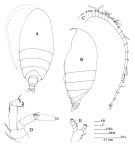 issued from : J.M. Bradford, L. Haakonssen & J.B. Jillett in Mem. N.Z. Oceanogr. Inst., 1983, 90. [p.74, Fig.41]. Female: A, habitus (dorsal); B, idem (lateral left side); C, A1; D, A2; E, Md (mandibular palp). Nota Female: Pediger segments 4 and 5 sepatated. - Posterolateral corners rounded, slightly produced. - Ventral side of genital segment with posteriorly produced shovel-like process which partly covers urosomal segment 2. - A1 slightly longer than metasome. - P5 absent.
|
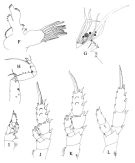 issued from : J.M. Bradford, L. Haakonssen & J.B. Jillett in Mem. N.Z. Oceanogr. Inst., 1983, 90. [p.75, Fig.41 (legend p.74)]. Female: F, Mx1; G, Mx2; H, Mxp; I, P1; J, P2; K, P3; L, P4. Nota Female: - P1 exopod segment 1 with 1 external spine.
|
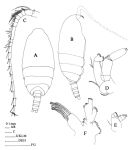 issued from : J.M. Bradford, L. Haakonssen & J.B. Jillett in Mem. N.Z. Oceanogr. Inst., 1983, 90. [p.76, Fig.42]. Male: A, habitus (dorsal); B, idem (lateral right side); C, A1; D, A2; E, Md (mandibular palp); F, Mx1. Nota Mele: - ,Similar to female, but corners of metasome not produced. - Mouthparts hardly reduced. - Left P5 biramous, exopod 3-segmented, endopod 1-segmented; right leg uniramous, with 2-segmented exopod of which terminal segment very short.
|
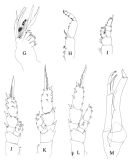 issued from : J.M. Bradford, L. Haakonssen & J.B. Jillett in Mem. N.Z. Oceanogr. Inst., 1983, 90. [p.77, Fig.42 (legend p.76)]. Male: G, Mx2; H, Mxp; I, P1; J, P2; K, P3; L, P4; M, P5.
|
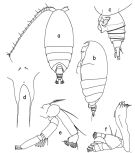 issued from : T. Park in Antarct. Res. Ser. Washington, 1983, 38 (3). [p.168, Fig.1]. Female: a, habitus (dorsal); b, idem (lateral left side); c, urosome (lateral left side); d, rostrum (anterior); e, A2; f, Md.
|
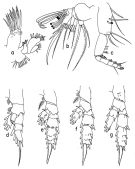 issued from : T. Park in Antarct. Res. Ser. Washington, 1983, 38 (3). [p.169, Fig.2]. Female: a, Mx1; b, Mx2; c, Mxp; d, P1 (anterior); e, P2 (posterior); f, P3 (posterior); g, P4 (posterior).
|
 issued from : T. Park in Antarct. Res. Ser. Washington, 1983, 38 (3). [p.170, Fig.3] Male: a, habitus (lateral left side); b, idem (dorsal); c, P5 (posterior); d, P5 (anterior); e, right P5 (lateral).
|
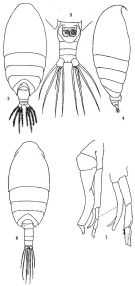 issued from: Q.-c Chen & S.-z. Zhang in Studia Marina Sinica, 1965, 7. [Pl.18, 3-7]. Female (from E China Sea): 3, habitus (dorsal); 4, idem (lateral right side); 5, urosome (ventral). Male: 6, habitus (dorsal); 7, P5 (anterior).
|
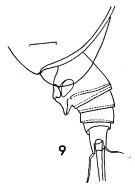 issued from : F.C. Ramirez in Revta Mus. La Plata, Seccion Zool., 1971, XI. [Lam.II, Fig.9]. Female (from off mar del Plata): 9, postrior part cephalothorax and urosome (lateral left side).
|
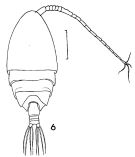 issued from : F.C. Ramirez in Revta Mus. La Plata, Seccion Zool., 1971, XI. [Lam.I, Fig.6]. Female: 6, habitus (dorsal). Scale bar in mm: 0.5.
|
 issued from: M. Rose in Annls Inst. océanogr., Monaco, 1942, XXI (3). [p.116, Fig.1]. Female (from Alger Bay, Algeria): habitus (dorsal and lateral, respectively); Ur, urosome (lateral and ventral, respectively). L: body length.
|
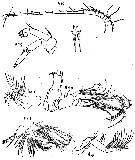 issued from : M. Rose in Annls Inst. océanogr., Monaco, 1942, XXI (3). [p.117, Figs.2, 3]. Female: A1; A2; R, rostrum; Md; Mx1 (as Mx); Mx2 (as Mxp1); Mxp (as Mxp2). Nota: A1 20-segmented.
|
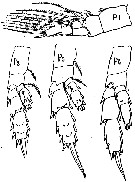 issued from : M. Rose in Annls Inst. océanogr., Monaco, 1942, XXI (3). [p.118, Fig.4]. Female: P1 to P4.
|
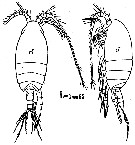 issued from : M. Rose in Annls Inst. océanogr., Monaco, 1942, XXI (3). [p.116, Fig.5]. Male: habitus (dorsal and lateral, respectively). L : body length.
|
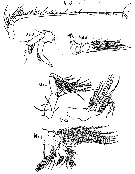 issued from : M. Rose in Annls Inst. océanogr., Monaco, 1942, XXI (3). [p.119, Figs.6, 7]. Male: A1; A2; Md; Mx1 (as Mx); Md; Mx2 (as Mxp1); Mxp (as Mxp2). Nota: A1 19-segmented (8th to 11th segments fused), 12th -13th segments and 18th - 19th segments with sketchings of fusion, these latter occasionally free from a side, fused another side in the same individual.
|
 issued from : M. Rose in Annls Inst. océanogr., Monaco, 1942, XXI (3). [p.120, Fig.8]. Male: P1 to P4.
|
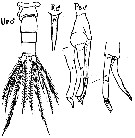 issued from : M. Rose in Annls Inst. océanogr., Monaco, 1942, XXI (3). [p.121, Fig.9]. Male: Ur, urosome (dorsal); R, rostrum; P5. Nota: genital segment weakly asymmetrical. Anal segment very short.
|
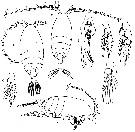 issued from : T. Mori in The pelagic Copepoda from the neighbouring waters of Japan, 1937 (2nd edit., 1964). [Pl.27, Figs.1-8]. Female: 1, 7, habitus (dorsal and lateral, respectively); 8, P1. Male: 2, habitus (dorsal); 3, P5; 4, P4 (posterior); 5, P2 (posterior); 6, P3 (posterior).
|
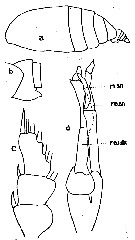 issued from : C.O. Esterly in Univ. Calif. Publs Zool., 1905, 2 (4). [p.164, Fig.26]. Female (from San Diego Region): a, habitus (lateral); b, genital segment (lateral); c, exopod of P1. Nota: 4th thoracic segment separate from 5th. 3rd and 4th abdominal segments broader than long. Genital segment with ventral shovel-shaped process. Exopod of A2 9/7 as long as the endopod; 7th segments of exopod without proximal bristle. 2nd basal of Mx1 with 5, endopod with 6, exopod with 5 bristles. Male: P5 (re.1 dx = 1st segment of exopod of right leg; re. sn = exopod of left leg; ri.sn = endopod of left leg).
|
 Issued from : W. Giesbrecht in Systematik und Faunistik der Pelagischen Copepoden des Golfes von Neapel und der angrenzenden Meeres-Abschnitte. – Fauna Flora Golf. Neapel, 1892. Atlas von 54 Tafeln. [Taf. 37, Fig. 6]. Female: 6, last thoracic segments and urosome (lateral, right side).
|
 Issued from : W. Giesbrecht in Systematik und Faunistik der Pelagischen Copepoden des Golfes von Neapel und der angrenzenden Meeres-Abschnitte. – Fauna Flora Golf. Neapel, 1892. Atlas von 54 Tafeln. [Taf. 13, Fig. 9]. Female: 9, Mx1 (posterior view)
|
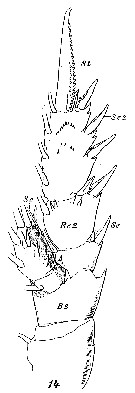 Issued from : W. Giesbrecht in Systematik und Faunistik der Pelagischen Copepoden des Golfes von Neapel und der angrenzenden Meeres-Abschnitte. – Fauna Flora Golf. Neapel, 1892. Atlas von 54 Tafeln. [Taf. 13, Fig.14 ]. Female: 14, P2 (posterior view).
|
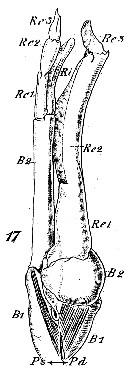 Issued from : W. Giesbrecht in Systematik und Faunistik der Pelagischen Copepoden des Golfes von Neapel und der angrenzenden Meeres-Abschnitte. – Fauna Flora Golf. Neapel, 1892. Atlas von 54 Tafeln. [Taf.13 , Fig. 17]. Female: 17, P5 (anterior view). Ps = left leg; Pd = right leg; B = basipod; Re = exopod; Ri = endopod.
|
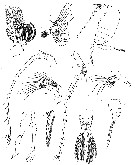 Issued from : G.S. Brady in Rep. Scient. Results Voy. Challenger, Zool., 1883, 8 (23). [Pl.XVII]. Female: 3, A1; 4, A2; 5, Md; 6, Mx1; 7, Mx2; 8, terminal spines of one of the swimming legs; 11, urosome; 12, same (lateral). Male: 1, habitus (lateral); 2, A1; 9, P5.
|
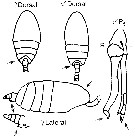 issued from : G. Harding in Key to the adullt pelagic calanoid copepods found over the continental shelf of the Canadian Atlantic coast. Bedford Inst. Oceanogr., Dartmouth, Nova Scotia, 2004. [p.44]. Female & Male. Nota: Female P5 absent. male: P5 with left leg almost as long as right.
|
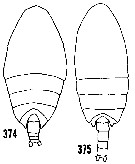 issued from : H.B. Owre & M. Foyo in Fauna Caribaea, 1967, 1, Crustacea, 1: Copepoda. [p59, Figs.374-375]. Female (from Florida Current): 374, habitus (dorsal). Nota: A1 extending past the metasome. Male: habitus (dorsal).
|
 issued from : H.B. Owre & M. Foyo in Fauna Caribaea, 1, Crustacea, 1: Copepoda. Copepods of the Florida Current. 1967. [p.22, Fig.99]. After Giesbrecht, 1892. Female: 89, urosome (lateral).
Nota: Genital segment with a posteriorly directed, shelf-like ventral projection.
|
 issued from : H.B. Owre & M. Foyo in Fauna Caribaea, 1967, 1, Crustacea, 1: Copepoda. [p23, Fig.93]. After Giesbrecht (1892). Male: 93, P5. Nota: left and right P5 of about equal length.
|
 issued from : N. Phukham in Species diversity of calanoid copepods in Thai waters, Andaman Sea (Master of Science, Univ. Bangkok). 2008. [p.216, Fig.90]. Female (from W Malay Peninsula): a, Habitus (dorsal); b, last thoracic segments and urosome (dorsal); c, P5. Male: d, habitus (dorsal); e, last thoracic segments and urosome (dorsal); f, P5. Body length after drawings: F = 1.973 mm; M = 1,939 mm.
|
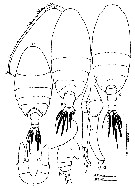 issued from : Mulyadi in Published by Res. Center Biol., Indonesia Inst. Sci. Bogor, 2004. [p.38, Fig.19]. Female (from Indonesian Seas): a, habitus (dorsal); b, urosome (lateral right side). Male: c, habitus (dorsal); d, P5. Immature male: e, habitus (dorsal); f, P5.
|
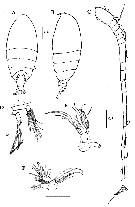 Issued from : H.Y. Soh, S.Y. Moon & J.H. Wi in Invertebrate Fauna of Korea (eds) Incheon: NIBR, 2013, 21 (28). [p.91, Fig.51]. Female (from Korean waters): A-B, habitus (dorsal and lateral, respectively); C, A1; D, A2; E, Md; F, Mx1. Scale bars: A, B = 300 µm; C-F = 20 µm.
|
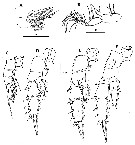 Issued from : H.Y. Soh, S.Y. Moon & J.H. Wi in Invertebrate Fauna of Korea (eds) Incheon: NIBR, 2013, 21 (28). [p.92, Fig.52]. Female: A, Mx2; B, Mxp; C, P1; D, P2; E, P3; F, P4. Scale bars: 20 µm.
|
 Issued from : H.Y. Soh, S.Y. Moon & J.H. Wi in Invertebrate Fauna of Korea (eds) Incheon: NIBR, 2013, 21 (28). [p.93, Fig.53]. Male: A-B, habitus (dorsal and lateral, respectively); C-D, A1; E, P5 (R = right leg; L = left leg); F, distal segment of left exopod. Scale bars: A, B = 300 µm; C-F = 20 µm.
|
 issued from : O. Tanaka in Publ. Seto Mar. Biol. Lab., 1962, X (1). [p.35]. Nota Female: - Cephalothorax about 4.5 times the abdomen length. - Head and 1st pedigerous segment fused, 4th and 5th thoraci segments separate. - Genital segment with a shovel-like process ventrally. - A1 19-segme,ted, extends to the distal end of the thoracic segment. - Mx1 with 9 setae on outer lobe; 5 setae on exopod; 6 setae on endopod; 4 setae on the 2nd basal segment; 3 setae on the 3rd inner lobe; 2 setae on the 2nd inner lobe; 10 setae on the 1st inner lobe (= arthrite). - P1 with 1 outer spine on the 1st exopodal segment. - P5 absent. Nota Male: Cephalothorax about 3.2 times the abdomen length. - Anal segment very short. - A1 extends to the end of the thoracic segment. - P5 with the terminal segment of the right leg very short.
|
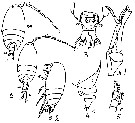 Issued from : M.C. Kos in Field guide for plankton. Zool Institute USSR Acad., Vol. I, 1972. After Brodsky, 1962. Female: 1-2, habitus (dorsal and lateral, respectively); 3, corner of the last thoracic segment and abdomen (ventral); 4, same (lateral); 5, P1. Male: 6, habitus (dorsal); 7, P5.
| | | | | Ref. compl.: | | | Cleve, 1904 a (p.197); Carl, 1907 (p.16); Rose, 1925 (p.152); Wilson, 1942 a (p.209); Sewell, 1948 (p.323); Wilson, 1950 (p.335); King & Hida, 1955 (p.11); Kott, 1957, p.5, 18); Yamazi, 1958 (p.149, Rem.); Deevey, 1960 (p.5, Table II, annual abundance); Heinrich, 1960 (tab.2); 1961 ( (p.87); Fagetti, 1962 (p.24); Cervigon, 1962 (p.181, tables: abundance distribution); Fish, 1962 (p.14); Grice & Hart, 1962 (p.287, 296: Rem.); Ganapati & Shanthakumari, 1962 (p.8, 16); Duran, 1963 (p.16); V.N. Greze, 1963 a (tabl.2); Gaudy, 1963 (p.24, Rem.); Ahlstrom & Thrailkill, 1963 (p.57, Table 5, abundance); Björnberg, 1963 (p.39, Rem.); Unterüberbacher, 1964 (p.24); De Decker, 1964 (p.16, 24, 27); De Decker & Mombeck, 1964 (p.14); Anraku & Azeta, 1965 (p.13, Table 2, fish predator); Grice & Hulsemann, 1965 (p.224); Mullin, 1966 (p.546, Table I, III, diet); Furuhashi, 1966 a (p.295, vertical distribution in Kuroshio region, Table 10); Mazza, 1966 (p.71); Neto & Paiva, 1966 (p.24, Table III); Grice & Hulsemann, 1967 (p.17); Fleminger, 1967 a (tabl.1); De Decker, 1968 (p.45); Evans, 1968 (p.14); Vinogradov, 1968 (1970) (p.78, 80, 81, 158); Dowidar & El-Maghraby, 1970 (p.269); Morris, 1970 (p.2300); Itoh, 1970 (tab.1); Park, 1970 (p.476); Timonin, 1971 (p.281, trophic group); Deevey, 1971 (p.224); Bainbridge, 1972 (p.61, Appendix Table I: vertical distribution vs day/night, Table II: %, Table IV: seasonal abundance); Brodsky, 1972 (p.256); Binet & al., 1972 (p.68); Roe, 1972 (p.277, tabl.1, tabl.2); 1972 b (p.540); Heinrich, 1973 (p.95); Björnberg, 1973 (p.332, 389); Corral Estrada & Pereiro Muñoz, 1974 (tab.I); Arashkevich, 1975 (p.351, digestion time); Ikeda, 1976 (p.51, respiration rate); Timonin, 1976 (p.79, vertical distribution); Deevey & Brooks, 1977 (p.256, tab.2, Station "S"); Timonin & Voronina, 1977 (p.290, fig.7); Carter, 1977 (1978) (p.36); Dessier, 1979 (p.205); Hayward, 1980 (p.295, Table 2, vertical distribution, feeding); Sreekumaran Nair & al., 1981 (p.493); Madhupratap & al., 1981 (p.262, Table 2 as dana: abundance vs. thermocline); Madhupratap & al., 1981 (p.266, fig.2b: abundance vs. geographic transect); Arashkevich & al., 1982 (p.477, Table 2, diet); Kovalev & Shmeleva, 1982 (p.84); Vives, 1982 (p.292); Dessier, 1983 (p.89, Tableau 1, 2, Rem., %); Minkina, 1983 (p.38, speed swimming); Turner & Dagg, 1983 (p.16, 22); Guangshan & Honglin, 1984 (p.118, tab.); De Decker, 1984 (p.316, 363: chart);Tremblay & Anderson, 1984 (p.6); Brenning, 1984 (p.6, T-S diagram, Rem.); Cummings, 1984 (p.163, Table 2); Brenning, 1985 a (p.23, Table 2); Sazhina, 1985 a (p.491, tab.3); Petipa & Borichenko, 1985 (tab.1,2); Kinzer & Schulz, 1985 (tab.4); Longhurst, 1985 (tab.2); Brinton & al., 1986 (p.228, Table 1); M. Lefèvre, 1986 (p.33); Madhupratap & Haridas, 1986 (p.105, tab.1); Chen Y.-Q., 1986 (p.205, Table 1: abundance %, fig.3, Table 2: vertical distribution); Ambler & Miller, 1987 (tab.2, 3, 4, 5); Jimenez-Perez & Lara-Lara, 1988; Wiebe & al., 1988 (tab.7); Lozano Soldevilla & al., 1988 (p.59); Dessier, 1988 (tabl.1); Herman, 1989 (p.247); Hernandez-Trujillo, 1989 a (tab.1); Cervantes-Duarte & Hernandez-Trujillo, 1989 (tab.3); Heinrich, 1990 (p.17); Hirakawa & al., 1990 (tab.3); Schulz, 1990 (p.188); Arinardi, 1991 (p.295); Yoo, 1991 (tab.1); Suarez & al., 1990 (tab.2); Suarez & Gasca, 1991 (tab.2); Hattori, 1991 (tab.1, Appendix); Santos & Ramirez, 1991 (p.79); Samba Diouf, 1991 (p.104); Hernandez-Trujillo, 1991 (1993) (tab.I, as dana); Suarez, 1992 (App.1); Yen & al., 1992 (p.495, tab.1, mechanoreception); Ayukai & Hattori, 1992 (p.163, Table 5, fecal pellet production rate); Gopalakrishnan & Balachandran, 1992 (p.167, figs.1, 3, Table 1, 2); Palomares Garcia & Vera, 1995 (tab.1); Webber & Roff, 1995 a (p.481, table 1, 2, 3, biomass, production); ); Shih & Young, 1995 (p.73); Suarez-Morales & Gasca, 1997 (p.1525); Go & al., 1997 (tab.1); Park & Choi, 1997 (Appendix); Padmavati & al., 1998 (p.347); Hure & Krsinic, 1998 (p.101); Hwang & al., 1998 (tab.II); Wong & al, 1998 (tab.2); Gilabert & Moreno, 1998 (tab.1, 2); Mauchline, 1998 (tab.23, 30, 63); Smith S. & al., 1998 (p.2369, Table 6, moonsoon effects); Suarez-Morales, 1998 (p.345, Table 1); Noda & al., 1998 (p.55, Table 3, occurrence); Gopalakrishnan & Saraledevi, 1998 (p.128, fig.1, chart); Suarez-Morales & Gasca, 1998 a (p.111); Gopalakrishnan & Saraledevi, 1998 (p.128, fig.1, chart); Hassett & Boehlert, 1999 (p.571); Hernandez-Trujillo, 1999 (p.284, tab.1); Lavaniegos & Gonzalez-Navarro, 1999 (p.239, Appx.1); Neumann-Leitao & al., 1999 (p.153, tab.2); Dolganova & al., 1999 (p.13, tab.1); Onishchik, 1999 (p.76); Lapernat, 2000 (tabl.3, 4); Razouls & al., 2000 (p.343, Appendix); Haury & al., 2000 (p.69, Table 1); Fernandez-Alamo & al., 2000 (p.1139, Appendix); Suarez-Morales & Gasca, 2000 (1247, tab.1); Suarez-Morales & al., 2000 (p.751, tab.1); Lopez-Salgado & al., 2000 (tab.1); Madhupratap & al., 2001 (figs.4, 5); Holmes, 2001 (p.60); Lo & al., 2001 (1139, tab.I); Madhupratap & al., 2001 (p. 1345, vertical distribution vs. O2, figs.4, 5: clusters); Rebstock, 2002 (p.71, Table 3, Fig.5, climatic variability); Beaugrand & al., 2002 (p.179, figs.5, 6); Hernandez-Trujillo & Suarez-Morales, 2002 (p.748, tab.1); Hwang & al., 2003 (p.193, tab.2); Shimode & Shirayama, 2004 (tab.2); Hsiao & al., 2004 (p.326, tab.1); Hsieh & al., 2004 (p.397, tab.1, p.399, tab.2); Wang & Zuo, 2004 (p.1, Table 2, dominance, origin); Lan & al., 2004 (p.332, tab.1); Lo & al.*, 2004 (p.218, tab.1, fig.6); Pusch & al., 2004 (251, tab.3); Gallienne & al., 2004 (p.5, tab.3); CPR, 2004 (p.62, fig.185); Lo & al., 2004 (p.89, tab.1); Shimode & al., 2005 (p.113 + poster); Berasategui & al., 2005 (p.313, fig.2); Zuo & al., 2006 (p.159, tab.1, 3, abundance, fig.8: stations group); Hwang & al., 2006 (p.943, tabl. I) ; Dias & Araujo, 2006 (p.65, Rem., chart); Lavaniegos & Jiménez-Pérez, 2006 (p.156, tab.2, 3, Rem.); Kuriyama & Nishida, 2006 (p.293, 300: Tab.II; fig.7, 10, vertical distribution); Valdés & al., 2007 (p.104: tab.1); Khelifi-Touhami & al., 2007 (p.327, Table 1); Dur & al., 2007 (p.197, Table IV); Jitlang & al., 2008 (p.65, Table 1); McKinnon & al., 2008 (p.844: Tab.1, fig.7); Neumann-Leitao & al., 2008 (p.799: Tab.II, fig.6); Morales-Ramirez & Suarez-Morales, 2008 (p.514, 522); Ayon & al., 2008 (p.238, Table 4: Peruvian samples); Fernandes, 2008 (p.465, Tabl.2); Raybaud & al., 2008 (p.1765, Table A1); Muelbert & al., 2008 (p.1662, Table 1); Tseng L.-C. & al., 2008 (p.153, fig.5, Table 2, occurrence vs geographic distribution, indicator species); Tseng & al., 2008 (p.402, Table 2); Lan Y.-C. & al., 2008 (p.61, Table 1, % vs stations); C.-Y. Lee & al., 2009 (p.151, Tab.2); Galbraith, 2009 (pers. comm.); Miyashita & al., 2009 (p.815, Tabl.II); Tseng & al., 2009 (p.327, fig.5, feeding); Lan Y.-C. & al., 2009 (p.1, Table 2, % vs hydrogaphic conditions); Hafferssas & Seridji, 2010 (p.353, Table 2, 3); Hafferssas & al., 2010 (p.1281, Table III, abundance vs spatial distribution); Williamson & McGowan, 2010 (p.273, Table III, Pacific central gyres: N & S); Hernandez-Trujillo & al., 2010 (p.913, Table 2); Cornils & al., 2010 (p.2076, Table 3); Schnack-Schiel & al., 2010 (p.2064, Table 2: E Atlantic subtropical/tropical); Dias & al., 2010 (p.230, Table 1); Mazzocchi & Di Capua, 2010 (p.427); Medellin-Mora & Navas S., 2010 (p.265, Tab. 2); W.-B. Chang & al., 2010 (p.735, Table 2, abundance); Shanthi & Ramanibai, 2011 (p.132, Table 1); Xu & Gao, 2011 (p.514, figs.3, 4, Table 2: optimal salinity); Hsiao S.H. & al., 2011 (p.475, Appendix I); Guo & al., 2011 (p.567, table 2, indicator); Kâ & Hwang, 2011 (p.155, Table 3: occurrence %); Tseng L.-C. & al., 2011 (p.47, Table 2, occurrences vs mesh sizes); Tutasi & al., 2011 (p.791, Table 1, 3, fig.8, abundance distribution vs La Niña event, Rem. p.797, fig.11); Selifonova, 2011 a (p.77, Table 1, alien species in Black Sea); Shiganova & al., 2012 (p.61, Table 4); Mulyadi & Rumengan, 2012 (p.202, Rem.: p.204); Tseng & al., 2012 (p.621, Table 3: abundance); Jang M.-C & al., 2012 (p.37, abundance and seasonal distribution); Salah S. & al., 2012 (p.155, Tableau 1); Hidalgo & al., 2012 (p.134, Table 2) ; Teuber & al., 2013 (p.28, Table 1, respiration rates); Teuber & al., 2013 (p.1, Table 1, 2, 3, abundance vs oxygen minimum zone, respiration rates, enzyme activity); Palomares-Garcia & al., 2013 (p.1009, Table I, abundance vs environmental factors); in CalCOFI regional list (MDO, Nov. 2013; M. Ohman, comm. pers.); Tseng & al., 2013 (p.507, seasonal abundance); Hirai & al., 2013 (p.1, Table I, molecular marker); Mendoza Portillo, 2013 (p.37: Fig.7, seasonal dominance); Lidvanov & al., 2013 (p.290, Table 2, % composition); Hwang & al., 2014 (p.43, Appendix A: seasonal abundance); Bonecker & a., 2014 (p.445, Table II: frequency, horizontal & vertical distributions); Lopez-Ibarra & al., 2014 (p.453, fig.6, biogeographical affinity); Dias & al., 2015 (p.483, Table 2, abundance, biomass, production); Bode & al., 2015 (p.268, Table 1, 2, figs.3, 4, chemical components, trophic level, geographic zone); Benedetti & al., 2016 (p.159, Table I, fig.1, functional characters); El Arraj & al., 2017 (p.272, table 2); Belmonte, 2018 (p.273, Table I: Italian zones); Palomares-Garcia & al., 2018 (p.178, fig.3: relative frequency, Table 1);Bode & al., 2018 (p.840, Table 1, respiration & ingestion rates); Dias & al., 2019 (p.1, Table II, IV, occurrrence, vertical distribution, Rem.: p.12); Acha & al., 2020 (p.1, Table 3: occurrence % vs ecoregions). | | | | NZ: | 19 + 1 douteuse | | |
|
Carte de distribution de Scolecithrix danae par zones géographiques
|
| | | | | | | | | | | | | | | 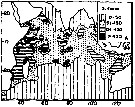 issued from : T.C. Gopalakrishnan & T. Balachandran in Oceanogr. Indian Ocean, 1992. [p.170, fig.3, A]. issued from : T.C. Gopalakrishnan & T. Balachandran in Oceanogr. Indian Ocean, 1992. [p.170, fig.3, A].
Distribution of Scolecithrix danae in the Indian Ocean.
Nota: Main occurences between 25° N - 40° S. |
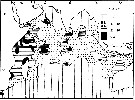 issued from : Gopalakrishnan & Saraledevi in Pelagic Biogeography ICoPB II. Proc. 2nd Int. Conf. Final report of SCOR/IOC working group 93. 9-14 July 1995. Workshop Rep. No.142. UNESCO, 1998. [p.129, Fig.1]. issued from : Gopalakrishnan & Saraledevi in Pelagic Biogeography ICoPB II. Proc. 2nd Int. Conf. Final report of SCOR/IOC working group 93. 9-14 July 1995. Workshop Rep. No.142. UNESCO, 1998. [p.129, Fig.1].
Distribution and abundance in number of specimens/haul standard of Scolecithrix danae in the Indian Ocean. |
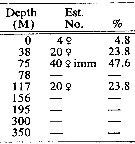 issued from : H.B. Owre & M. Foyo in Fauna Caribaea, 1967, 1, Crustacea, 1: Copepoda. [p.60, Table 24]. issued from : H.B. Owre & M. Foyo in Fauna Caribaea, 1967, 1, Crustacea, 1: Copepoda. [p.60, Table 24].
Vertical distribution of Scolecithrix danae in the Florida Current (SL station, A1-9).
Nota: This species is moderately abundant throughout the year, where over 70 p.cent of the specimens were caught in the upper 100 m. |
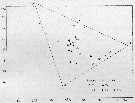 issued from : U. Brenning in Wiss. Z. Wilhelm-Pieck-Univ. Rostock - 33. Jahrgang 1984. Mat.-nat. wiss. Reihe, 6. [p.7, Figs.3]. issued from : U. Brenning in Wiss. Z. Wilhelm-Pieck-Univ. Rostock - 33. Jahrgang 1984. Mat.-nat. wiss. Reihe, 6. [p.7, Figs.3].
T-S Diagram for Scolecithrix danae from 8° S - 26° N; 16°- 20° W, and Namibia ( expedition VIII: 21/9-17/12 1976/, for different expeditions (V1: Dec. 1972- Jan. 1973; V2: Feb/Mar.1973; VI: May 1974; IV: Jun./Jul. 1972).
SO: Southern Surface Water (S °/oo: 34,50; T°C: 29,0); ND: Northern Water of the Surface Layer (S °/oo: 37,5; T°C: 21,0); SD: Southern Deep Water of the surface layer (S °/oo: 35,33; T°C: 13,4). See commentary in Temora stylifera and Brenning (1985 a, p.6). |
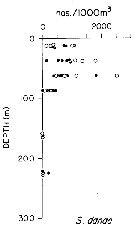 issued from : T.L. Hayward in Mar. Biol., 1980, 58. [p.299, Fig.2]. issued from : T.L. Hayward in Mar. Biol., 1980, 58. [p.299, Fig.2].
Plots of day (open circle) and night (filled circle) depth distributions of Scolecithrix danae in the North Pacific central gyre (main sampling location: 25°N, 155°W with drogue), September 1968. |
 issued from : T.L. Hayward in Mar. Biol., 1980, 58. [p.302, Fig.4]. issued from : T.L. Hayward in Mar. Biol., 1980, 58. [p.302, Fig.4].
Day and night feeding indices (relative degree of gut fullness of copepods collected under differing environmental conditions) for females Scolecithrix danae from N Pacific central gyre (main sampling location: 28°N, 155°W), June 1973.
Numbers in abscisse : stations. |
 Issued from : P. Tutasi, S. Palma & M. Caceres in Scienc. Mar., 2011, 75 (4). [p.798, Fig.8 c] Issued from : P. Tutasi, S. Palma & M. Caceres in Scienc. Mar., 2011, 75 (4). [p.798, Fig.8 c]
Geographic distribution of Scolecithrix danae in September and October 2001, associated with the weak La Niña event of 2001. |
 Issued from : P.-E. Lapernat in DEA Océanogr. Biol., Univ. P. & M. Curie, Paris VI. July 5, 2000. [Fig.10 d]. Issued from : P.-E. Lapernat in DEA Océanogr. Biol., Univ. P. & M. Curie, Paris VI. July 5, 2000. [Fig.10 d].
Verical distribution of Scolecithrix danae at an oligotrophe site (off NW Cape Verde Islands: 21° N, 31° W) in females (F) and males (M) (ind. per m3) in the day (white circle) and night (black circle).
Nota: Sampling in the water column 0-1000 m, one during the day and another during the night with BIONESS multiple-net: 0-75; 75-150; 150-250; 250-350; 350-450; 450-550; 550-700; 700-850; 850-965 m. In May-June 1992. |
 Issued from : C.O. Dias, A.V. de Araujo & S.L.C. Bonecker in An. Acad. Bras. Ciênc., 2019, 91 (1). [p.10, Fig.4, a, b] Issued from : C.O. Dias, A.V. de Araujo & S.L.C. Bonecker in An. Acad. Bras. Ciênc., 2019, 91 (1). [p.10, Fig.4, a, b]
Study area in The Campos basin (Brazil) showing the seasonal variation of Scolecithrix danae (ind.m3) at 1 m depth, during the rainy season (a) and the dry season (b).
Nota: This species among Scolecitrichidae is relatively common and the most abundant in the surface and subsurface layers during both the day and night. In the Campos Basin the species was found throught the water column down to a depth of 1,200 m. This species was also recorded by Wheeler (1970) at depths between 4,100 and 2,200 m. |
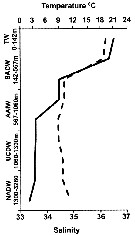 Issued from : C.O. Dias, A.V. de Araujo & S.L.C. Bonecker in An. Acad. Bras. Ciênc., 2019, 91 (1). [p.4, Fig.1] Issued from : C.O. Dias, A.V. de Araujo & S.L.C. Bonecker in An. Acad. Bras. Ciênc., 2019, 91 (1). [p.4, Fig.1]
Temperature and Salinity of the five water masses (0-3,260 m) in the Campos Basin (central bBazilian coast) modified from Bonecker & al. (2014).
Solid line: temperature; dashed line: salinity.
TW: Tropical Water; SACW: South Atlantic Central Water; AAIW: Antarctic Intermediate Water; UCDW: Upper Circumpolar Deep Water; NADW: North Atlantic Deep Water. |
 Issued from : M.K. Webber & J.C. Roff in Mar. Biol., 1995, 123. [p.484, Table 1]. Issued from : M.K. Webber & J.C. Roff in Mar. Biol., 1995, 123. [p.484, Table 1].
Length-weight regression of Scolecithrix danae in oceanic waters of Discovery Bay (Jamaica) in 60- and 200 m vertical hauls, using 200- and 64-µm mesh aperture of plankton nets, from June 1989 to July 1991 (monthly samples). |
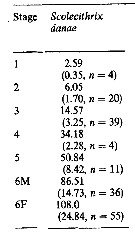 Issued from : M.K. Webber & J.C. Roff in Mar. Biol., 1995, 123. [p.485, Table 2]. Issued from : M.K. Webber & J.C. Roff in Mar. Biol., 1995, 123. [p.485, Table 2].
Mean biomass (µg) of copepodite stages for Scolecithrix danae from Discovery Bay (Jamaica) with standard deviation and n number of individuals measured. |
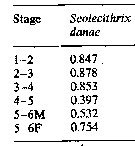 Issued from : M.K. Webber & J.C. Roff in Mar. Biol., 1995, 123. [p.485, Table 3]. Issued from : M.K. Webber & J.C. Roff in Mar. Biol., 1995, 123. [p.485, Table 3].
Stage weight increments (In mmmax mmin-1 for Scolecithrix danae from Discovery Bay (Jamaica), caculated from mean biomass of each stage. |
 Issued from : M. Bode, R. Koppelmann, L. Teuber, W. Hagen & H. Auel inGlobal Biogeochemical Cycles, 2018, 32. [p.844, Table 1). Issued from : M. Bode, R. Koppelmann, L. Teuber, W. Hagen & H. Auel inGlobal Biogeochemical Cycles, 2018, 32. [p.844, Table 1).
Cf. explanations of these measures in Calanoides natalis from the same authors. |
| | | | Loc: | | | Antarct. (Indian) (in Brady, 1918), South Africa (E & W), off E Tristan da Cunha, Namibia, Angola, off S St. Helena Is., Congo, Atlant. (central equatorial), G. of Guinea, Ivorian shelf, off E St. Paul Is., Dakar, Argentina, Uruguay (continental shelf), Brazil (S, off Macaé, Rio de Janeiro, Campos Basin), off Vitoria-Cabo de Sao Tomé), Caribbean (off Pinos Is.), Yucatan, Caribbean Colombia, Cariaco Basin, Cape Verde Is., off NW Cape Verde Is., off Morocco-Mauritania, Cap Ghir (Morocco), Great Meteor Seamount, Canary Is., off Madeira, Lisboa, off W Azores, off Natal, off Amazon, Barbados Is., Venezuela, Caribbean Sea, Jamaica, Yucatan, E Costa Rica, G. of Mexico, Florida, Sargasso Sea, off Bermuda: Station ‘’ S’’ (32°10’N, 64°30’W), Delaware Bay (outside), Long Island Sound, Woods Hole, Bay of Fundy, off Nova Scotia, off S Newfoundland, off W Ireland, Medit. (Baleares, Algiers, Gulf of Annaba, Marseille, Ligurian Sea, Napoli, Strait of Messina, Malta, S Adriatic Sea, Ionian Sea, Alexandria, Black Sea), G. of Aden, Arabian Sea, Laccadives Is., Kavaratti Is., Maldive Is., Sri Lanka, Natal, Madagascar (Nosy Bé), Mascarene Basin, Rodrigues Is. - Seychelles, India (Lawson's Bay), E India, equatorial & S Indian Ocean, Bay of Bengal, Andaman Sea, W Malay Peninsula (Andaman Sea), W Australia, Indonesia-Malaysia, Java Sea, Flores Sea, Banda Sea, Ambon Bay, Celebes Sea, Philippines, G. of Tonkin, China Seas (Yellow Sea, East China Sea, South China Sea), Taiwan Strait, Taiwan (S, E, SW, W, NW, N, NE, Mienhua Canyon), Okinawa, S Korea, Korea Strait, Japan Sea, Japan (Nagasaki, Tanabe Bay), off SE Japan, off S Shikoku Is., Kuroshio zone, Kuchinoerabu Is., off Sanriku, off SE Hokkaido, Alaska, Pacif. W (equatorial), N Pacific (central gyre), Australia (SE, Great Barrier, New South Wales, Shark Bay, North West Cape), New Caledonia, New Zealand, Bikini Is., Carolina-Marshall Is., off NE Marquesas Is., Moorea Is., Hawaii, off NE Hawaii, Oregon, Pacif. (equatorial, N central subtropical), Pacific (central gyres: N & S), Guaymas Basin, California, W Baja California, Bahia Magdalena, Gulf of California, La Paz, W Mexico, G. de Tehuantepec, off W Guatemala, W Costa Rica, W Central America, Costa Rica (Dome), off Galapagos, Ecuador, off Peruvian coast, Pacif. (SE tropical), S Pacif. (NPFZ), Chile, off Santiago. | | | | N: | 333 | | | | Lg.: | | | (6) F: 2,52-2,24; M: 2,44-2,34; (9) F: 2,2-2,05; M: 2,1; (16) F: 2,15-1,8; M: 2,15-2; (34) F: 2,16; (45) F: 2,25-2; M: 2,15-1,85; (47) F: 2,2; M: 2,15-2; (66) F: ± 2,32; (72) F: 2,17-2,01; M: 2,17-2,07; (73) F: 2,28-2,04; M: 2,31-2,12; (75) F: 2,16-1,9; M: 2,16-1,95; (101) F: 2,14-1,9; M: 2,21-1,97; (104) M: 2,1; (117) F: 2,2-2,1; M: 2,1; (142) F: 2,2-2; M: 2,2-2; (147) F: 2,2; M: 1,65; (150) F: 2,2- 2,1; ; M: 2,1; (180) F: 2,08; (187) F: 2,12-1,94; (199) F: 2,2-1,9; M: 2,13-1,98; (237) F: 2,1; M: 1,9; (290) F: 2-2,15; M: 1,9-2,1; (327) F: 2,24-1,94; M: 1,97; (332) F: 2,14-1,99; (333) F: 2,21-2,03; M: 1,92; (334) F: 2,2; M: 2,15-2; (336) F: 2,2-2,1; M: 2,1; (432) F: 2,15-2,1; (530) F: 2; M: 1,8; (785) F: 3,49-1,93; M: 3,63; (786) F: 2,19-1,94; M: 2,39-2,05; (864) F: 1,83-1,97; (865) F: 2; (991) F: 1,8-2,4; M: 1,92-2,25; (1000) F: 2,0 ± 0,1; M: 2,0 ± 0,1; (1111) F: 2,0-2,4; M: 2,05-2,36; (1122) F: 2,1; M: 1,95; (1125) F: 2,4; (1174) F: 1,78-1,80; M: 1,67-1,69; (1230) F: 2,1-2,4; M: 2,1-2,2; {F: 1,78-2,52; M: 1,65-2,44}
Fish (1962) gives maximal sizes for females and males appearing too much high (785). | | | | Rem.: | épi-mésopélagique.
Sampling depth (Antarct.) : 0-1000 m.
Voir aussi les remarques en anglais | | | Dernière mise à jour : 25/10/2022 | |
|
|
 Toute utilisation de ce site pour une publication sera mentionnée avec la référence suivante : Toute utilisation de ce site pour une publication sera mentionnée avec la référence suivante :
Razouls C., Desreumaux N., Kouwenberg J. et de Bovée F., 2005-2025. - Biodiversité des Copépodes planctoniques marins (morphologie, répartition géographique et données biologiques). Sorbonne Université, CNRS. Disponible sur http://copepodes.obs-banyuls.fr [Accédé le 01 décembre 2025] © copyright 2005-2025 Sorbonne Université, CNRS
|
|
 |
 |















































